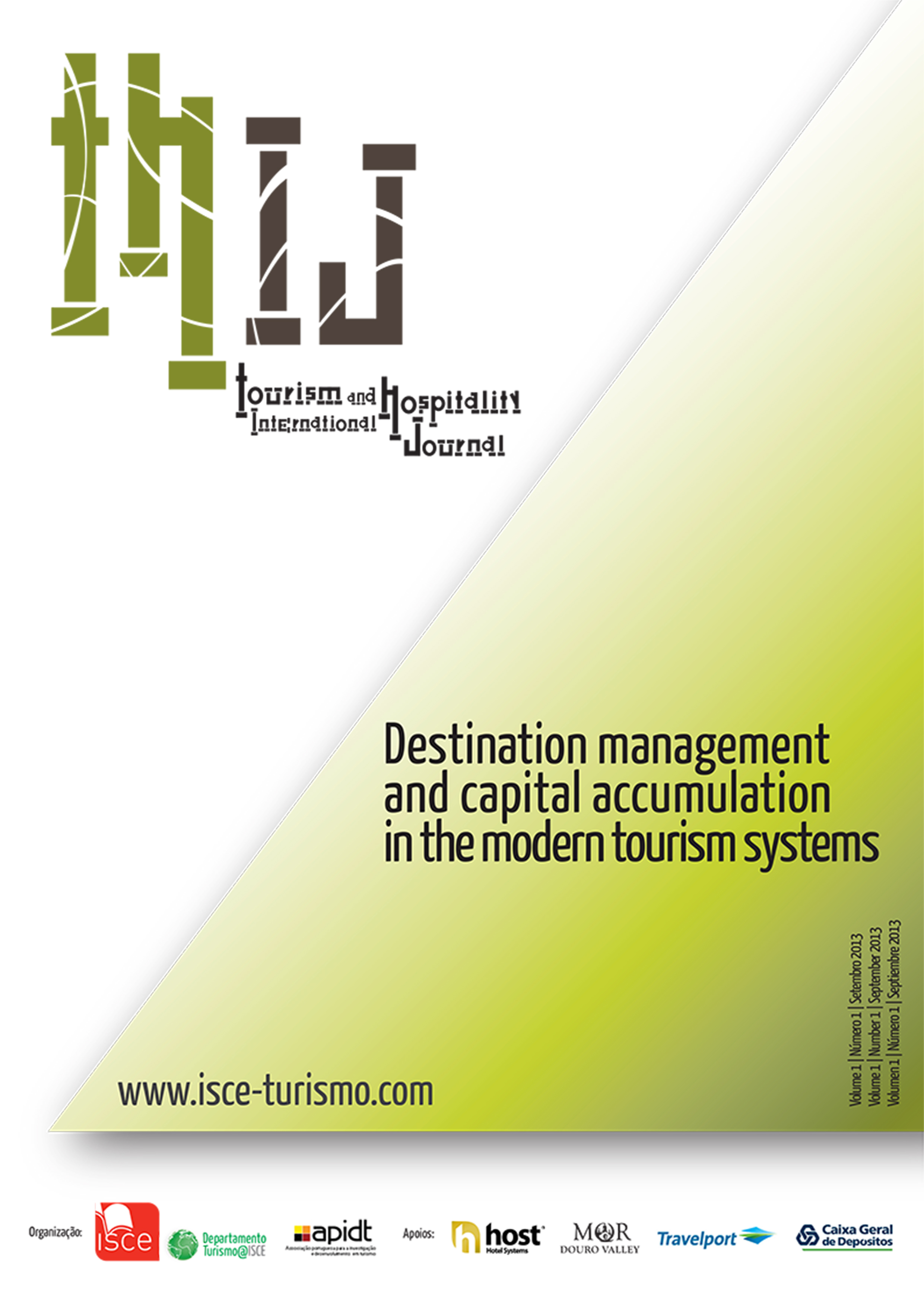The effects of place of residence on tourist motivations: a revised case of the urban quadrangle of Minho
DOI:
https://doi.org/10.57883/thij1(1)2013.30087Palavras-chave:
Análise factorial, motivações push e pull, Quadrilátero Urbano do Minho, turismoResumo
Este estudo busca capturar as razões subjacentes às decisões turísticas dos residentes do Quadrilátero Urbano do Minho (composto pelos municípios de Barcelos, Braga, Guimarães e Vila Nova de Famalicão). Os objetivos deste estudo preliminar são a três níveis. Em primeiro lugar, identificar os fatores motivacionais push e pull dos residentes do Quadrilátero Urbano do Minho. Em segundo lugar, o estudo examina se há diferenças entre as motivações turísticas dos residentes destes quatro municípios. Finalmente, o estudo investiga se existem diferenças nas motivações daqueles que escolhem destinos nacionais e internacionais. A metodologia inclui investigação quantitativa baseada em dados da implementação de um inquérito aos residentes do Quadrilátero Urbano do Minho, aplicado em 2012. A análise fatorial é utilizada para identificar seis fatores push e sete fatores pull. A comparação dos valores médios destes fatores por município e por residentes que escolhem destinos nacionais e internacionais revela que os fatores mais valorizados e menos valorizados são comuns aos quarto municípios e aos dois grupos de residentes (aqueles que escolhem destinos nacionais e internacionais).
Referências
Câmara Municipal de Braga (2008). Quadrilátero Urbano para a Competitividade, a Inovação e a Internacionalização – Programa Estratégico de Cooperação [cited 10 May 2012]. Available from World Wide Web: http://www.cm-braga.pt/wps/wcm/connect/ffd4d70040aa39ba934c9b4b94834e1e/PECQuadrilatero.pdf?MOD=AJPERES.
Crompton, J. (1979). Motivations for pleasure vacation. Annals of Tourism Research, 6, 408-424.
Dann, G. (1977). Anomie ego-enhancement and tourism. Annals of Tourism Research, 4, 184-194.
Hair, J., Anderson, R., Tatham, R. & Black, W. (1998) Multivariate data analysis: With readings. Englewood Cliffs: Prentice Hall.
INE. Censos 2011 – Recenseamento da População e Habitação - Resultados Provisórios. Lisboa: Instituto Nacional de Estatística. 2011. [cited 10 May 2012]. Available from World Wide Web: http://www.ine.pt/xportal/xmain?xpid=INE&xpgid=ine_publicacoes&PUBLICACOESpub_boui=122073978&PUBLICACOEStema=55466&PUBLICACOESmodo=2.
Jang, S. & Cai, L. (2002). Travel motivations and destination choice: a study of British outbound market. Journal of Travel & Tourism Marketing, 13, 111-133.
Jonsson, C. & Devonish, D. (2008). Does nationality, gender, and age affect travel motivation? A case of visitors to the Caribbean island of Barbados. Journal of Travel & Tourism Marketing, 25, 398-408.
Kim, K., Jogaratnam, G. & Noh, J. (2006). Travel decisions of students at a US university: segmenting the international market. Journal of Vacation Marketing, 12, 345-357.
Kozak, M. (2002). Comparative analysis of tourist motivations by nationality and destinations. Tourism Management, 23, 221-232.
McGehee, N., Murphy, L. & Uysal, M. (1996). The Australian international pleasure travel market: motivations from a gendered perspective. The Journal of Tourism Studies, 7, 45-57.
Meng, F. & Uysal, M. (2008).Effects of gender differences on perceptions of destination attributes, motivations, and travel values: an examination of a nature-based resort destination. Journal of Sustainable Tourism, 16, 445-466.
Downloads
Publicado
Como Citar
Edição
Secção
Licença
Direitos de Autor (c) 2023 This work is licensed under a Creative Commons - Attribution 4.0 International (CC BY 4.0)

Este trabalho encontra-se publicado com a Licença Internacional Creative Commons Atribuição 4.0.
Este trabalho encontra-se publicado com a Licença Internacional Creative Commons Atribuição 4.0.






